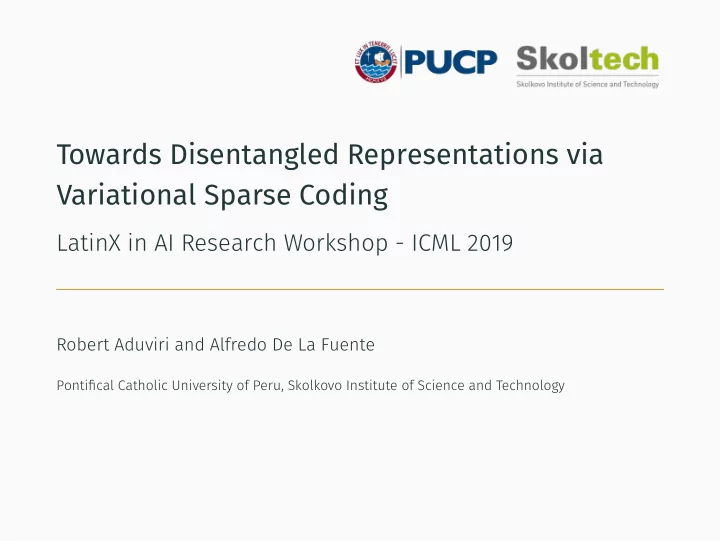

LatinX in AI Research Workshop - ICML 2019 Robert Aduviri and Alfredo De La Fuente Pontifical Catholic University of Peru, Skolkovo Institute of Science and Technology Towards Disentangled Representations via Variational Sparse Coding
1. Motivation 2. Research Problem 3. Technical Contribution 4. Current Results 5. Next Steps 1 Table of contents
Motivation
• Simple machine learning algorithms depend heavily on the representation of the data they are given. • The process of designing the right representation for a specific them automatically. 2 Representation Learning task is commonly known as feature engineering . • An alternative to hand-design these representations is to learn
Generative Models to the rescue! etc). 3 Representation Learning • Lower dimensional representation of raw data (images, text, • Efficiently sample from a high-dimensional data distribution. • Latent space with meaningful properties.
3 etc). Representation Learning • Lower dimensional representation of raw data (images, text, • Efficiently sample from a high-dimensional data distribution. • Latent space with meaningful properties. → Generative Models to the rescue!
Proposed by Kingma & Welling (2013) and Rezende et al. (2014) (1) latent prior distribution be? 4 Variational AutoEncoders (VAE) L ( θ, φ ) = E q φ ( z | x ) [ log p θ ( x | z )] − KL ( q φ ( z | x ) ∥ p ( z )) How expressive can a Gaussian
produce a smooth latent representation of the data. Both the reconstruction loss and the KL divergence are necessary to 5 VAE vs AE
6 VAE latent codes distribution
Constitutes the complex task of learning representations that Scheme from the paper “Towards a Definition of Disentangled Representations” by Higgins et al. (2018) 7 Disentanglement separate the underlying structure of the world into disjoint parts of its representation .
Proposed by Higgins et al. (2017) as a constrained version of VAE to discover disentangled latent factors. (2) Azimuth(orientation) traversal comparison. 8 β - VAE L Beta ( θ, φ ) = E q φ ( z | x ) [ log p θ ( x | z )] − β KL ( q φ ( z | x ) ∥ p ( z ))
Created by Matthey et al. (2017) as a way to assess the disentangle- ment properties of unsupervised learning methods. These 2D shapes were procedurally generated from 6 ground truth independent latent factors: color, shape, scale, rotation, x and y positions of a sprite. 9 dSprites Dataset
Research Problem
We aim to tackle the following challenges: • Meaningful low-dimensional representations of images • Interpretable and disentangled features on latent space. • Quantitatively and qualitative evaluation of disentanglement. 10 Learning Disentangled Representations
We aim to tackle the following challenges: • Meaningful low-dimensional representations of images • Interpretable and disentangled features on latent space. • Quantitatively and qualitative evaluation of disentanglement. 10 Learning Disentangled Representations
We aim to tackle the following challenges: • Meaningful low-dimensional representations of images • Interpretable and disentangled features on latent space. • Quantitatively and qualitative evaluation of disentanglement. 10 Learning Disentangled Representations
Technical Contribution
11 (3) variation. J The model captures subjectively understandable sources of (4) J which leads to a recognition function as a discrete mixture model, Variational Sparse Coding (VSC) Tonolini et al. (2019) suggest the use of a Spike-and-Slab prior p ( z ) . ∏ ( ) p s ( z ) = α N ( z j ; 0 , 1 ) + ( 1 − α ) δ ( z j ) j = 1 ( ) ∏ q φ ( z | x i ) = γ i , j N ( z i , j ; µ z , i , j , σ 2 z , i , j ) + ( 1 − γ i , j ) δ ( z i , j ) j = 1
A convolutional architecture was used for the encoder/decoder of the VAE and VSC for comparison, based on the configuration used by Hig- gins et al. (2017). 12 Convolutional encoder/decoder Figure 1: Convolutional architecture used for VAE and VSC
Current Results
dSprites dataset. 13 Latent Codes Comparison Figure 2: Reconstruction and latent codes of Convolutional VSC (left) ( α = 0 . 01, β = 2) and Convolutional VAE (right) ( β = 2) models with the
14 Latent Space Traversal via VSC Figure 3: Latent traversals on MNIST (left) and Fashion-MNIST (right).
15 Latent Space Traversal via VSC Figure 4: Latent traversals on CelebA (left) and dSprites (right).
Convolutional VAE (right) models with the dSprites and CelebA datasets. 16 Latent Space Traversal Comparison Figure 5: Latent traversals using the Convolutional VSC (left) and
Next Steps
The quantitative evaluation of disentanglement is a recent area of research, with several metrics being constantly proposed, in addition to new models and datasets: Gap, SAP score, DCI, MCE, IRS Cars3D, Shapes3D 17 Disentanglement Metrics and Models • Metrics: BetaVAE score, FactorVAE score, Mutual Information • Models: BetaVAE, FactorVAE, BetaTCVAE, DIP-VAE, InfoGAN • Datasets: dSprites, Color/Noisy/Scream-dSprites, SmallNORB,
• Perform quantitative disentanglement evaluation with previously proposed metrics. • Extend comparison with recent models also proposed for disentanglement, both VAE-based and GAN-based. • Perform ablation studies for key features of the model, such as the sparse prior, -VAE regularization and encoder/decoder used. 18 Next Steps
• Perform quantitative disentanglement evaluation with previously proposed metrics. • Extend comparison with recent models also proposed for disentanglement, both VAE-based and GAN-based. • Perform ablation studies for key features of the model, such as the sparse prior, -VAE regularization and encoder/decoder used. 18 Next Steps
• Perform quantitative disentanglement evaluation with previously proposed metrics. • Extend comparison with recent models also proposed for disentanglement, both VAE-based and GAN-based. • Perform ablation studies for key features of the model, such as used. 18 Next Steps the sparse prior, β -VAE regularization and encoder/decoder
Our source code and experiments are available at: github.com/Alfo5123/Variational-Sparse-Coding See you at the poster session! robert.aduviri@pucp.edu.pe alfredo.delafuente@skoltech.ru 19 Thank you!
Recommend
More recommend